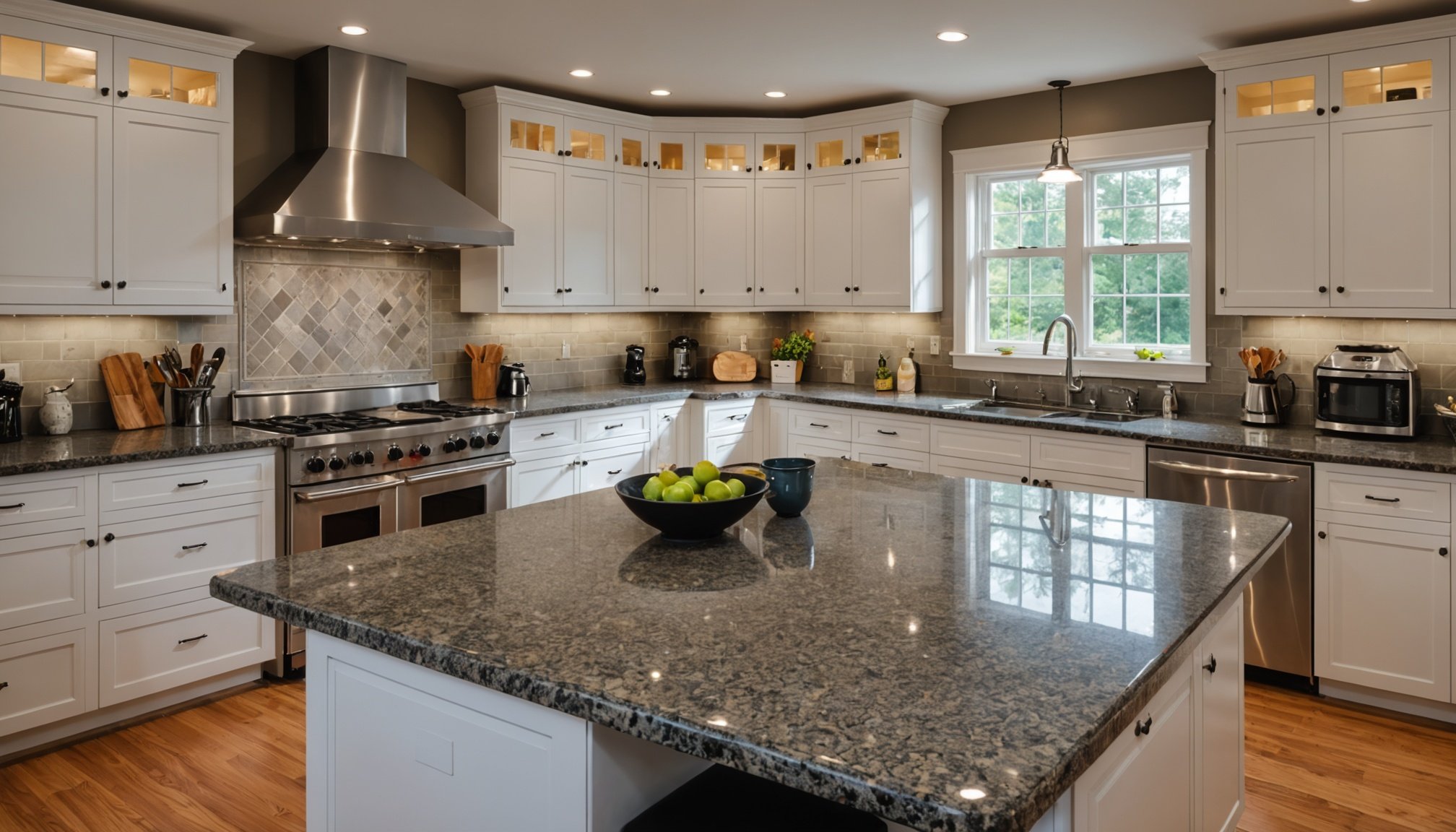Selecting the right kitchen countertop material is essential for maintaining hygiene in your home. Certain surfaces are more resistant to bacterial growth, making them ideal for food preparation. This guide explores various materials, comparing their antimicrobial properties and ease of cleaning. Each option offers unique benefits, ensuring you can choose a countertop that suits your lifestyle while prioritizing safety. Discover how informed decisions can enhance both your kitchen's aesthetics and its functionality.
Overview of Kitchen Countertop Materials
Exploring the essentials of kitchen surfaces for health-conscious choices.
Additional reading : Essential Storage Techniques for Cooking Oils: How to Keep Your Kitchen Essentials Fresh!
Common Materials
Selecting the right kitchen countertop materials is crucial for maintaining health and hygiene. Popular options include granite, quartz, laminate, and stainless steel. Each offers unique benefits and challenges. Granite, for instance, is durable and heat-resistant but requires sealing to prevent bacterial growth. Quartz, a non-porous alternative, is easy to clean, reducing the risk of bacteria.
Health and Hygiene
The choice of countertop material significantly impacts health and hygiene. Materials with antibacterial properties can help minimize bacterial presence. Stainless steel and certain treated laminates are known for their resistance to germs. However, natural stones like granite and marble can harbor bacteria if not properly sealed and maintained.
Have you seen this : Discover the Best Lighting Solutions to Transform Your Kitchen into a Warm and Inspiring Culinary Space
Bacterial Growth Potential
Understanding the bacterial growth potential on different surfaces is essential. Here's a quick comparison:
| Material | Bacterial Resistance | Maintenance Required |
|---|---|---|
| Granite | Moderate | High |
| Quartz | High | Low |
| Laminate | Moderate | Moderate |
| Stainless Steel | Very High | Low |
Choosing materials with antibacterial properties and low maintenance needs can enhance kitchen hygiene. By considering these factors, homeowners can make informed decisions that prioritize both aesthetics and health.
Antibacterial Properties of Popular Countertop Materials
Delving into the effectiveness of different surfaces against bacteria.
Quartz Countertops
Quartz countertops are renowned for their non-porous nature, which inherently resists bacterial growth. This quality makes quartz a favored choice for those prioritizing hygiene. The surface does not harbor bacteria, providing a cleaner and safer environment for food preparation. Additionally, its low maintenance requirement further enhances its appeal for health-conscious homeowners.
Granite's Natural Qualities
While granite is often celebrated for its durability, it also possesses natural antibacterial qualities. However, these properties are contingent upon proper sealing. Unsealed granite can become a breeding ground for bacteria. Regular sealing is essential to maintain its antibacterial effectiveness, ensuring that the surface remains both beautiful and hygienic.
Laminate's Limitations
Laminate countertops offer a cost-effective solution but come with limitations regarding bacteria resistance. Unlike quartz and granite, laminate surfaces can be more susceptible to bacterial growth. This is due to their porous nature, which can trap moisture and bacteria. To mitigate this, regular cleaning and proper maintenance are crucial.
Comparison of Countertop Materials:
- Quartz: High resistance, non-porous
- Granite: Moderate resistance, requires sealing
- Laminate: Lower resistance, requires frequent cleaning
Choosing the right material involves balancing aesthetic preferences with the need for a hygienic kitchen environment.
Comparative Analysis of Countertop Materials
Examining the balance between durability and hygiene in countertop choices.
Antibacterial Properties and Durability
When selecting kitchen countertops, understanding the balance between durability and hygiene is crucial. Different materials offer varying levels of antibacterial properties and require different maintenance efforts. For instance, granite is known for its strength but demands regular sealing to maintain its antibacterial effectiveness. In contrast, quartz is both durable and non-porous, providing high resistance to bacteria with minimal upkeep.
Ease of Cleaning and Maintenance
The ease of cleaning is a significant factor in maintaining a hygienic kitchen. Here's a quick overview:
- Quartz: High resistance, low maintenance
- Granite: Moderate resistance, requires sealing
- Laminate: Lower resistance, frequent cleaning needed
- Stainless Steel: Very high resistance, easy to clean
Hygiene Ratings
Choosing the right countertop involves considering its hygiene ratings alongside its durability. Quartz scores high for its hygiene due to its non-porous surface. Stainless steel also ranks highly, thanks to its inherent germ resistance. On the other hand, laminate requires diligent cleaning to maintain hygiene due to its susceptibility to bacterial growth. Selecting a material that aligns with your hygiene priorities and maintenance capabilities can lead to a healthier kitchen environment.
Maintenance Tips for Bacterial Control
Effective strategies for ensuring countertop hygiene and safety.
Best Practices for Cleaning
Maintaining a hygienic kitchen begins with regular countertop maintenance. It's essential to clean surfaces daily using a mild detergent and warm water. For deeper disinfection, use a solution of equal parts water and vinegar, which is effective and safe for most materials. For granite and quartz, avoid acidic cleaners to prevent surface damage.
Recommended Cleaning Products
Choosing the right products is crucial for maintaining health safety. For quartz countertops, opt for pH-balanced cleaners to preserve their non-porous nature. Granite requires a specially formulated cleaner to maintain its seal. Laminate surfaces benefit from gentle, non-abrasive cleaners to avoid scratches.
- Quartz: pH-balanced cleaner
- Granite: Stone-specific cleaner
- Laminate: Non-abrasive cleaner
Frequency of Maintenance
Regular cleaning is key to minimizing bacterial growth. Quartz and stainless steel require weekly deep cleaning due to their high resistance. Granite should be resealed annually to maintain its antibacterial properties, with monthly inspections for wear. Laminate demands frequent cleaning, ideally after each use, to prevent moisture trapping.
By adhering to these maintenance tips, homeowners can ensure their countertops remain not only clean but also health-safe, aligning with their hygiene priorities.
Expert Insights on Countertop Selection
Drawing on professional opinions to guide your countertop choices.
Interviews with Experts
Industry experts in kitchen design and hygiene emphasize the importance of selecting materials that balance aesthetics with health benefits. According to Dr. Emily Carter, a hygiene specialist, "Choosing non-porous materials like quartz can significantly reduce bacterial growth, making them ideal for families with health concerns."
Trends in Antibacterial Materials
Recent trends highlight the growing popularity of antibacterial materials in kitchen design. Experts suggest that materials such as stainless steel and treated quartz are increasingly favored for their low maintenance and high resistance to bacteria. These materials are not only practical but also align with modern design preferences.
Recommendations for Families
For families with specific health concerns, experts recommend considering both the material's antibacterial properties and its ease of maintenance. Here are key recommendations:
- Quartz: Ideal for families seeking low-maintenance, hygienic surfaces
- Stainless Steel: Suitable for those prioritizing durability and germ resistance
- Granite: Best for those willing to invest in regular sealing for added protection
By consulting with experts and understanding current trends, homeowners can make informed decisions that prioritize both style and health safety in their kitchen environments.
Case Studies: Real-Life Applications
Exploring practical experiences with antibacterial kitchen materials.
Examples of Kitchens Utilizing Antibacterial Materials
In various kitchen case studies, homeowners have implemented antibacterial materials to enhance cleanliness and safety. One notable example is a family in Seattle who chose quartz countertops for their non-porous nature, significantly reducing bacterial presence. Another household in Miami opted for stainless steel surfaces, praised for their germ resistance and modern appeal.
User Experiences with Different Countertop Choices
Users have reported diverse experiences with their countertop choices. A couple in New York found that their granite countertops, although beautiful, required frequent sealing to maintain hygiene. Conversely, a Chicago-based chef appreciated the low maintenance of quartz, which provided a consistently clean surface for food preparation.
Analysis of Outcomes Related to Cleanliness and Safety
The outcomes of these practical applications highlight the importance of material selection in maintaining a hygienic kitchen. Here's a quick analysis:
- Quartz: High satisfaction due to ease of cleaning
- Stainless Steel: Preferred for its durability and safety
- Granite: Requires commitment to regular maintenance
These user experiences emphasize that informed decisions regarding kitchen materials can lead to improved cleanliness and safety, aligning with the priorities of health-conscious homeowners.
Cost Considerations and Budgeting
Analyzing the financial aspects of selecting kitchen countertops.
Overview of Costs
When considering countertop costs, it's essential to evaluate both the initial investment and the long-term value. Materials like granite and quartz typically have higher upfront costs, reflecting their durability and antibacterial properties. In contrast, laminate offers a more budget-friendly option, though it may require more frequent replacement.
Long-term Value vs. Initial Investment
Choosing a countertop involves balancing the initial investment with potential long-term value. While quartz and stainless steel may seem costly initially, their low maintenance and high resistance to bacteria can offer savings over time. Conversely, laminate might incur additional costs due to its lower durability and higher maintenance needs.
Budgeting Tips
Effective budgeting is crucial when selecting the right countertop. Consider the following tips:
- Prioritize materials that align with your hygiene needs and budget.
- Evaluate the long-term value of investing in durable, low-maintenance surfaces.
- Plan for potential maintenance costs, especially for materials like granite that require sealing.
By understanding the relationship between countertop costs and value, homeowners can make informed decisions that support both their financial and health priorities.
Visual Aids and Resources
Enhancing understanding through visual tools and additional resources.
Infographics for Material Comparisons
Utilizing visual aids such as infographics can significantly aid in comparing various countertop materials. These tools visually represent differences in antibacterial properties, durability, and maintenance requirements, making it easier for homeowners to make informed decisions. An infographic might include a chart comparing granite, quartz, laminate, and stainless steel in terms of cost, hygiene, and visual appeal.
Additional Resources for Countertop Selection
For those seeking further guidance, accessing comprehensive resources can be invaluable. Look for online guides and expert reviews that delve into the specifics of kitchen countertops. These resources can provide detailed insights into the long-term benefits and potential drawbacks of each material.
Visual Guides for Maintenance Practices
Incorporating visual guides into your routine can streamline maintenance practices. For instance, step-by-step cleaning methods for each countertop type can be illustrated through diagrams or videos. These guides can show how to effectively clean quartz without damaging its surface or how to properly seal granite to maintain its antibacterial properties. By leveraging these resources, homeowners can ensure their countertops remain both beautiful and hygienic.













